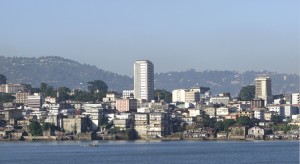Wreckage is removed from the Freetown suburb of Regent in the days after a mudslide devastated the Sierra Leone hillside community on Aug. 14, 2017. Credit: © Stringer/Anadolu Agency/Getty Images
Last week, in the early hours of August 14, heavy rains and flooding caused a massive mudslide on the outskirts of Freetown, the capital city of the small west African nation of Sierra Leone. The mudslide buried parts of Regent, a settlement perched on the slopes of Mount Sugar Loaf overlooking Freetown. The mudslide destroyed or severely damaged hundreds of homes and other buildings and killed 499 people. The death toll is certain to rise, however, as some 600 people remain missing. Rescue efforts continue a week after the disaster, but there is little hope of finding anyone alive in the mud and destruction.
The population of Freetown and its outskirts has increased sharply in recent years, and makeshift shantytowns have sprung up in Regent and other areas. As land is cleared for homes, however, the deforestationweakens the soil—particularly on the slopes of Sugar Loaf—greatly increasing the risk of land- and mudslides. Environmental groups have planted many trees, trying to replenish parts of the forest, but they can not keep up with the pace of clearing and unregulated development. Climate change, too, is adding to the problem, as more severe and erratic weather patterns bring unusually heavy rains. This summer has been exceptionally wet in and around Freetown, and floodwaters further destabilized the Sugar Loaf hillsides. Torrential downpours saturated the area in the days preceding the mudslide.

The port city of Freetown, the capital of Sierra Leone, sits between hills and the Atlantic Ocean. Credit: © Shutterstock
Entire parts of Regent were buried in the mudslide, which sent mucky waters cascading through other settlements and into the streets of Freetown itself. Some 3,000 people have been left homeless by the disaster, another 10,000 people have been evacuated from areas at risk of further mudslides, and the Sierra Leone government is asking thousands more to leave potentially dangerous areas. Survivors face threats from cholera and other waterborne diseases as the many deaths and destruction have tainted the area’s water supplies. International aid is pouring into Freetown, however, providing clean water, food, shelter, and medical supplies.
Further rains have hampered rescue efforts in Regent, and there is a shortage of heavy equipment to dig through and remove the many tons of mud covering homes and streets. The day after the disaster, Sierra Leone President Ernest Bai Koroma declared seven days of mourning as bodies began being retrieved and buried—most of them unidentified—in mass graves at nearby cemeteries. Since then, many survivors have ignored warnings to keep away and returned to the devastation to search for missing family members and retrieve belongings.
On August 16, two days after the disaster in Sierra Leone, a similar mountain mudslide struck the fishing village of Tora on the banks of Lake Albert in the Democratic Republic of the Congo, killing more than 200 people. There, the disaster was also caused by unusually heavy rains and deforestation for the creation of makeshift housing.
Untitled Document Can't view the linked articles? Subscribe to World Book Online

World Book Online delivers a progressive sequence of core databases supported by supplemental
tools, such as language translation, graphic organizers, and unique Webquests. Moving from
Early World of Learning to World Book Advanced, World Book Online aligns end-users with their
appropriate learning levels. Each stand-alone site provides additional features to support the
needs of users’ specific capabilities.
The World Book Difference
World Book combines cutting-edge technology with traditional editorial excellence to produce
authoritative, trustworthy, and unbiased content. The digital content is updated in real time and
carefully curated for each learning level. Accessible 24/7, the content is available on a variety of devices.
World Book Online combines 21st-century instructional techniques with timely information.
By breaking down complex topics and using easily understandable text, World Book Online helps to
build fluency and increase comprehension. Featuring single sign-on capability, these sites are paired
with highly visual content to engage even the most reluctant reader. Our collection of resources kindles
a lifelong learning experience for every user. This adherence to clarity, currency, and accuracy makes
World Book’s digital offerings an information hub for the classroom, library, and beyond.
|